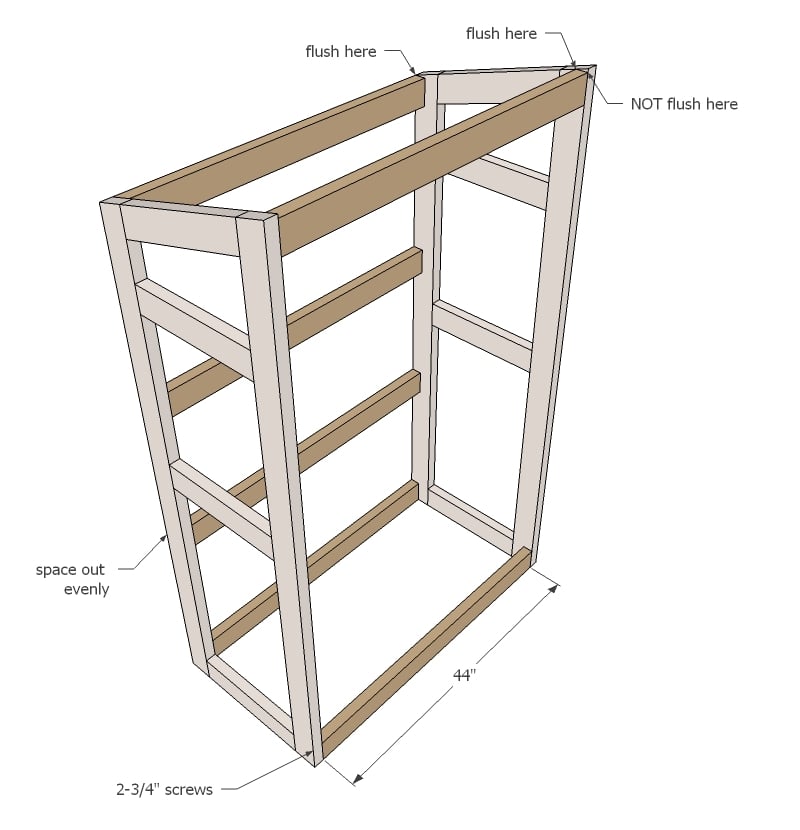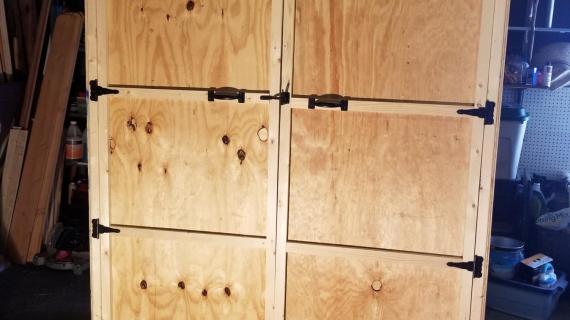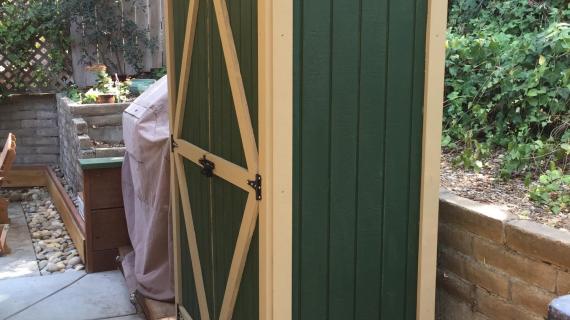
DIY outdoor shed or closet converted to a smokehouse. Free plans by ANA-WHITE.com

Preparation
2 - sheets of 1/2" plywood (does NOT include material for doors)
12 - 2x4 @ 8 feet long
6 - Gate style hinges
2 handles and latch
Galvanized nails for attaching plywood or exterior screws
Roofing for 48" x 26-1/2" roof
Additional material needed for doors and shelving
SIDE PANELS
2 - 2x4 @ 70-3/8" longest point measurement, one end cut at 15 degrees off square
2 - 2x4 @ 75-7/8" longest point measurement, one end cut at 15 degrees off square
2 - 2x4 @ 17-5/8" long point to short point measurement, both ends cut at 15 degrees off square
6 - 2x4 @ 17"
FRAME PIECES
6 - 2x4 @ 44"
2 - 2x4 @ 21-3/4" long point to short point measurement, both ends cut at 15 degrees off square (rafters)
3 - 2x4 @ 75" (door supports)
PLYWOOD
2 - 1/2" plywood @ 24" x 75-7/8" (cut down on one end to 69-1/2")*
1 - 1/2" plywood @ 48" x 69-1/2"
1- 1/2" plywood @ 48" 26-1/2" (use scrap from back)
DOORS - ~21-1/2" x ~68" - Make 1-1/2" thick overall where hinges are placed. Should be cut to fit.
*Cut full sheet of plywood in half the lengthwise, than cut the two side panels from those pieces. Pieces should be cut in mirror for finished side out.
Please read through the entire plan and all comments before beginning this project. It is also advisable to review the Getting Started Section. Take all necessary precautions to build safely and smartly. Work on a clean level surface, free of imperfections or debris. Always use straight boards. Check for square after each step. Always predrill holes before attaching with screws. Use glue with finish nails for a stronger hold. Wipe excess glue off bare wood for stained projects, as dried glue will not take stain. Be safe, have fun, and ask for help if you need it. Good luck!
Instructions
Step 1
Step 2
Step 3
Step 4
Step 7
It is always recommended to apply a test coat on a hidden area or scrap piece to ensure color evenness and adhesion. Use primer or wood conditioner as needed.



























Comments
kus140
Sun, 10/18/2015 - 21:51
This will make a nice pump
This will make a nice pump house for the well.
MoFord
Thu, 04/30/2020 - 09:37
Oh my gosh!!! I am going to…
Oh my gosh!!! I am going to doctor this up a bit and make a tack locker for my saddles and other horse stuff!!! I can't wait. I will be sure to post pics!
aceecee
Tue, 09/22/2020 - 13:00
We built it...excellent plans! (We are NOT at ALL handy!)
My husband and I built a garden tool shed using these plans. (We needed exactly this size for our available space...THANK YOU!) We are not handy at ALL, but when the person who was supposed to build it was delayed, we thought we could try it, or at least start. We bought a lower-end Kreg pocket jig and a secondhand mitre saw, and set to work, using T1-11 siding. We ended up building the entire shed ourselves! I'm not sure how to post a photo here (I just registered and this is my first comment), but we are very proud of the end result. The hardest part was building the doors, since we weren't really sure how to construct them. We also couldn't figure out how to get the double doors to stay tightly shut, but ended up using a rotating block at the bottom and it works great.